Braid "herringbone" on the frame (photo 88). Weave was developed by master Anna Ivanova. Used in the decoration sculptures, compositions of flowers.
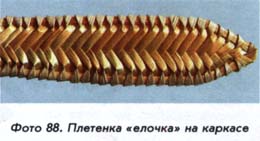
1. Prepare from straws taken from the middle part of the stem, 6 strips of width 3 mm and length of 35 cm wet strips with a knife smoothen the wrong side, so she had no rough edges.
2. Take 3 strips. One position horizontally by turning the wrong side facing you. The other two strips connect together wrong side and fold the first (figure 5.47 a).
Note. Further, when considering weaving, we will use the term "straw" instead of the term "bar".
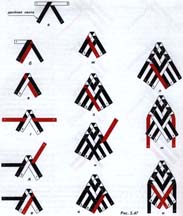
3. Braid straw 1, 2, 3 and 4 area according to the scheme (figure 5.47 b).
4. Take the next straw from the harvested strips. Put her face to his under the straws 1 and 2 straws on top of 3 and 4 (figure 5.47 d).
5. Working straw 6 fold (figure 5.47 d). Fold it around the straw and 4 proplatit between the straws 1 and 4 (figure 5.47 e). After proplyene 6 Solomin turned to face you.
6. Repeat step 5 for the working of the straw 5 (figure 5.47 f). Culm 5 3 appetite a straw and place on top of Solomin 2 and 6 (figure 5.47 f).
7. Insert 2 strips face to his, braiding the ends under the above schemes (figure 5.47 d—f). After stumble all Solomin network will look as shown in figure 5.47. z.
We continue weaving the available straws. The straw 3 and 4 will guides. The angle between the straws remains the same as at the beginning of the weaving.
8. Working straw 1 bend away from you (figure 5.47). 4 appetite around the straw and lay on top Solomin netting (figure 5.47).
9. Repeat step 8 for the working of the straw 2 (figure 5.47 l).
10. Guides the straw 3 and 4 point parallel to each other, holding them in this position (figure 5.47 m).
11. Consistently appetite workers Solomin guides, using methods that are described in step 8 (figure 5.47).
Bringing together and expanding the straw guides 3 and 4, you can do the weave in the shape resembling the petal of a flower or a bird feather.
After netting all of the straw tie together. The braids give the necessary bending.
Twist "feather" (photo 89). Weave was developed by master Anna Ivanova and is used as a decorative. The edge is formed by the set of ends of the straws outwardly, it resembles a bird feather, leaf pinnate plants.
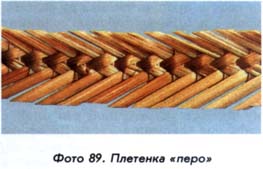
1. From straws taken from the middle part of the stem, prepare 20 strips of width 4 mm and length 15— 20 cm.
2. Take 3 straws. Two of them cross at the top, turn right sides to yourself. Third place under the intersection of the purl side facing you (figure 5.48 a).
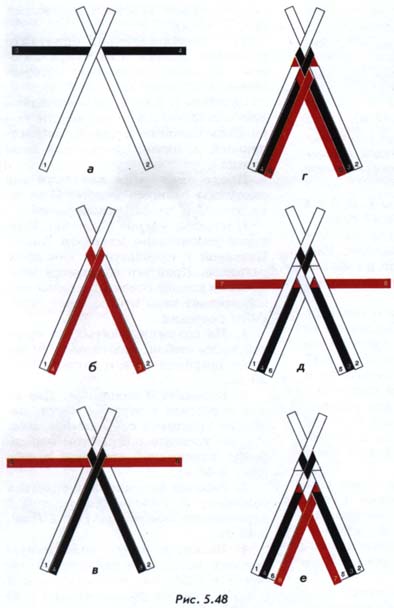
3. Working culm 4 appetite a straw 2. Working culm 3 twist of the straw 1 and 4 (figure 5.48 b).
4. Take a new straw striped. Insert it the wrong side facing you, under the straw 4 and 3 (the ends fall on the straw 1 and 2) (figure 5.48).
5. Working stubble 5 bend away from you and proplatit between 1 and 4 straws. The working straw 6 bend away from you and proplatit between 2 and 3 straws. Solomina 6 lie on top of Solomin 5 and 3 (figure 5.48 g).
6. The following straw stripe paste the purl side facing you, under the straw 5 and 6. Further, it will be held over the next couple Solomin (3, 4) and the ends it will remain under extreme straws (figure 5.48 d).
7. Working straw 7 bend away from you and proplatit between 4 and 6 straws. The working straw 8 bend away from you and proplatit between 3 and 5 straws. Solomina 8 will fall on top of Solomin 5 and 7 (figure 5.48).
Continue stitching, putting in the new straw strips under the middle of the straw overlapping, repeating steps 6 and 7. The weaving is as long as it is required by your plan. The protruding ends of straw ribbons after netting trim on your chosen size and contour. The weaving gives it a nice smooth curve.
Braid "catfish" with two guidesand (photo 90). Braid was developed by master Love selivonchyk.
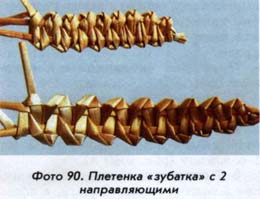
Wicker can be made of any diameter of straws. The elegance and beauty of the weave are manifested most clearly when vypletenii his thin straws. Can be used when the decorative leaves for small compositions. A special feature is its ability to perform the two-tone element.
1. Take 4 long straw from the top of the stem with a diameter of 1.5 mm. Tie them together at the ends in a thin flat beam. Spread the straw, leaving the straw 1 and 2 pointing down (they will be the guide), the straw 3 and 4 take the left, a straw 3 position before culm 4 (figure 5.49 a).
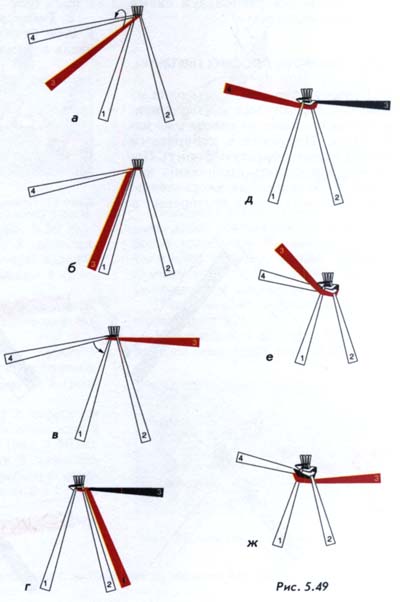
2. Working straw 3 fold away from you through a straw 4 and place parallel to Solomin 1 (figure 5.49 a, b).
3. Working straw 3 straws twist between 1 and 2, placing it in front of culm, and 1 for head stubble 2 (figure 5.49).
4. Working stubble 4 bend away from you for a straw 1. Twist between the straws 1 and 2. Fold away from you through a straw 3, placing it in parallel Solomin 2 (figure 5.49 g).
Working 4 a straw interlace between the 2 straws and 1, placing it in front of culm 2 and head for stubble 1 (figure 5.49 d).
6. Working straw 3 bend away from you and twist between the 2 straws and 1 (it goes for culm 2 and rests on top of the straw 1). Working get above a straw 3 straw 4 (figure 5.49).
7. Working from a straw 3 fold itself around the straw and 4 twist between the straws 1 and 2 (working Solomina 3 passes in front of culm, and 1 falls for culm 2) (figure 5.49 W).
Continue weaving by repeating steps 4-7. Netting is possible to perform two-tone, if the straw 3 and 4 take different colors such as natural straw color and the other was green. The straw guide can be positioned at different angles relative to each other, to reconcile and to remove, thereby changing the silhouette of the braids. After netting all of the straw tie together. Of the long rails can make a blade of braids using weave pattern "chain".



